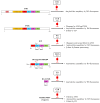Inhibition of the Self-Assembly of Aβ and of Tau by Polyphenols: Mechanistic Studies
- PMID: 31234523
- PMCID: PMC6630797
- DOI: 10.3390/molecules24122316
Inhibition of the Self-Assembly of Aβ and of Tau by Polyphenols: Mechanistic Studies
Abstract
The amyloid-β (Aβ) peptide and tau protein are thought to play key neuropathogenic roles in Alzheimer's disease (AD). Both Aβ and tau self-assemble to form the two major pathological hallmarks of AD: amyloid plaques and neurofibrillary tangles, respectively. In this review, we show that naturally occurring polyphenols abundant in fruits, vegetables, red wine, and tea possess the ability to target pathways associated with the formation of assemblies of Aβ and tau. Polyphenols modulate the enzymatic processing of the amyloid-β precursor protein and inhibit toxic Aβ oligomerization by enhancing the clearance of Aβ42 monomer, modulating monomer-monomer interactions and remodeling oligomers to non-toxic forms. Additionally, polyphenols modulate tau hyperphosphorylation and inhibit tau β-sheet formation. The anti-Aβ-self-assembly and anti-tau-self-assembly effects of polyphenols increase their potential as preventive or therapeutic agents against AD, a complex disease that involves many pathological mechanisms.
Keywords: Alzheimer′s disease; amyloid assemblies; amyloid-β self-assembly; neurofibrillary tangles; polyphenols; tau hyperphosphorylation; tau self-assembly.
Conflict of interest statement
The authors declare no conflict of interest.
Figures









Similar articles
-
Oligomerization and Conformational Change Turn Monomeric β-Amyloid and Tau Proteins Toxic: Their Role in Alzheimer's Pathogenesis.Molecules. 2020 Apr 3;25(7):1659. doi: 10.3390/molecules25071659. Molecules. 2020. PMID: 32260279 Free PMC article. Review.
-
Coffee and caffeine potentiate the antiamyloidogenic activity of melatonin via inhibition of Aβ oligomerization and modulation of the Tau-mediated pathway in N2a/APP cells.Drug Des Devel Ther. 2014 Dec 24;9:241-72. doi: 10.2147/DDDT.S71106. eCollection 2015. Drug Des Devel Ther. 2014. Retraction in: Drug Des Devel Ther. 2022 Nov 21;16:4041-4042. doi: 10.2147/DDDT.S397859. PMID: 25565776 Free PMC article. Retracted.
-
In vitro comparison of major memory-support dietary supplements for their effectiveness in reduction/inhibition of beta-amyloid protein fibrils and tau protein tangles: key primary targets for memory loss.Sci Rep. 2021 Feb 15;11(1):3001. doi: 10.1038/s41598-020-79275-1. Sci Rep. 2021. PMID: 33589649 Free PMC article.
-
Interactions between Aβ and mutated Tau lead to polymorphism and induce aggregation of Aβ-mutated tau oligomeric complexes.PLoS One. 2013 Aug 12;8(8):e73303. doi: 10.1371/journal.pone.0073303. eCollection 2013. PLoS One. 2013. PMID: 23951348 Free PMC article.
-
Interaction between Aβ and Tau in the Pathogenesis of Alzheimer's Disease.Int J Biol Sci. 2021 May 27;17(9):2181-2192. doi: 10.7150/ijbs.57078. eCollection 2021. Int J Biol Sci. 2021. PMID: 34239348 Free PMC article. Review.
Cited by
-
Polyphenols in Alzheimer's Disease and in the Gut-Brain Axis.Microorganisms. 2020 Jan 31;8(2):199. doi: 10.3390/microorganisms8020199. Microorganisms. 2020. PMID: 32023969 Free PMC article. Review.
-
The Role of Liquid-Liquid Phase Separation in the Accumulation of Pathological Proteins: New Perspectives on the Mechanism of Neurodegenerative Diseases.Aging Dis. 2024 Apr 20;16(2):769-786. doi: 10.14336/AD.2024.0209. Aging Dis. 2024. PMID: 38739933 Free PMC article. Review.
-
Stability and anti-proliferative properties of biologically active compounds extracted from Cistus L. after sterilization treatments.Sci Rep. 2020 Apr 16;10(1):6521. doi: 10.1038/s41598-020-63444-3. Sci Rep. 2020. PMID: 32300137 Free PMC article.
-
Temperature-Dependent Aggregation of Tau Protein Is Attenuated by Native PLGA Nanoparticles Under in vitro Conditions.Int J Nanomedicine. 2025 Feb 14;20:1999-2019. doi: 10.2147/IJN.S494104. eCollection 2025. Int J Nanomedicine. 2025. PMID: 39968061 Free PMC article.
-
Epigallocatechin-3-Gallate Provides Protection Against Alzheimer's Disease-Induced Learning and Memory Impairments in Rats.Drug Des Devel Ther. 2021 May 13;15:2013-2024. doi: 10.2147/DDDT.S289473. eCollection 2021. Drug Des Devel Ther. 2021. PMID: 34012254 Free PMC article.
References
-
- Lazo N.D., Maji S.K., Fradinger E.A., Bitan G., Teplow D.B. The amyloid-β protein. In: Sipe J.D., editor. Amyloid Proteins-the Beta Sheet Conformation and Disease. Wiley-VCH; Weinheim, Germany: 2005. pp. 385–491.
Publication types
MeSH terms
Substances
Grants and funding
LinkOut - more resources
Full Text Sources

